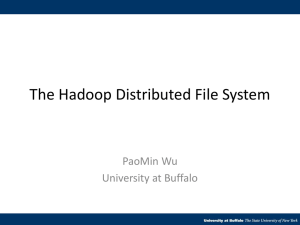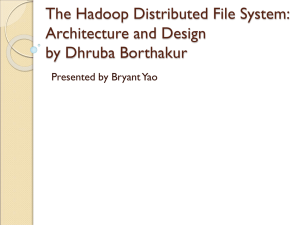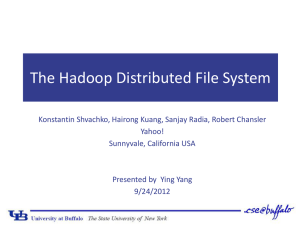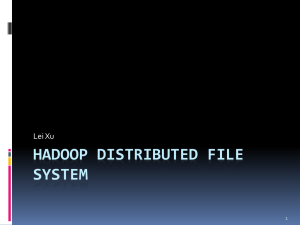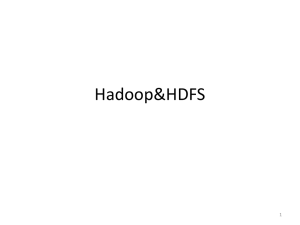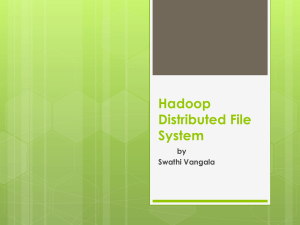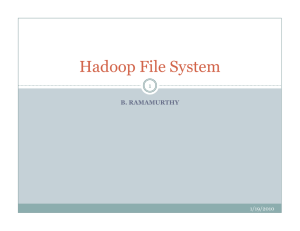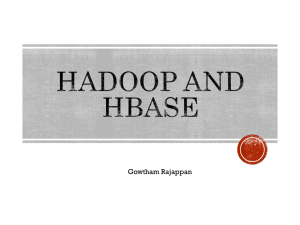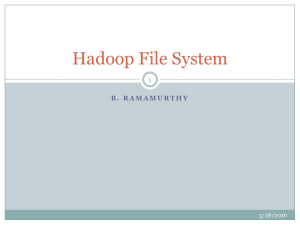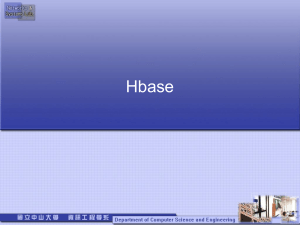File
advertisement
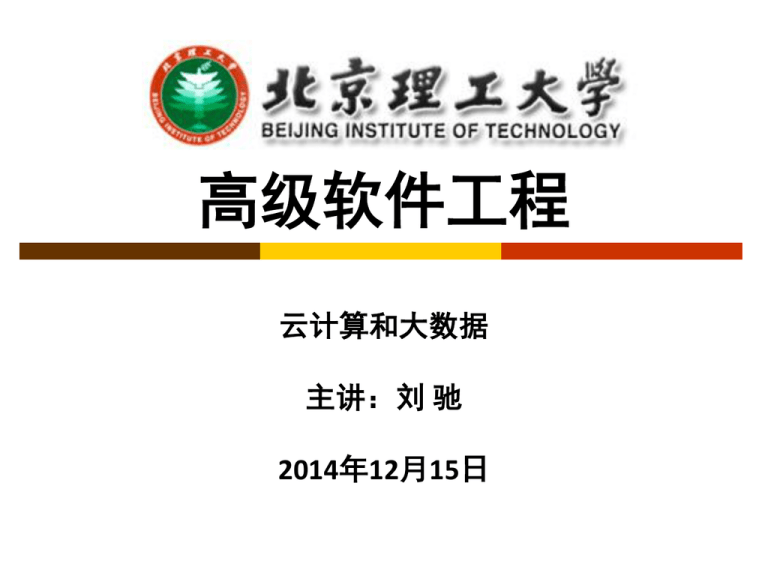
高级软件工程 云计算和大数据 主讲:刘 驰 2014年12月15日 Content Cloud Computing Hadoop HDFS MapReduce HBase 2 为什么需要云计算? 案例一: 写文件 电脑硬盘坏了,文件丢失 存储在云中的文件不会丢失 3 为什么需要云计算? 案例二: QQ聊天 --- 下载、安装、使用 使用C++---下载、安装、使用 …… 从云中获取服务 4 为什么需要云计算? 案例三: 华盛顿邮报突然需要大量计算资源进行文件格式 转化 报社现有计算能力每页需要30分钟 新闻时效性不允许 使用Amazon EC2的计算资源 5 5 云计算产生的原动力 芯片与硬 件技术 Web2.0 技术 资源虚拟 化 互联网技 术 面向服务 构架 软件即服 务 6 云计算的分类 按服务类型 基础设施即服务IaaS • 基础设施云 平台即服务PaaS • 平台云 软件即服务SaaS • 应用云 7 云计算分类 服务类型分类 分类 服务类型 运用灵活性 运用难易程度 IaaS 接近原始的计算存储能力 高 难 PaaS 应用的托管环境 中 中 SaaS 特定功能 低 易 8 云计算分类 不同类型云的案例 9 云计算分类 按服务方式分 10 云构架层次 共有云 (通过Internet提 供公共服务) 混合云 (通过Internet和 Intranet提供公共 和私有服务) 私有云 (通过Intranet提 供私有服务) 应用层 软件及服务(SaaS) 平台层 平台即服务(PaaS) 基础设施层 基础设施即服务(Iaas) 11 IaaS基本功能 资源抽象 计费管理 安全管理 资源部署 资源监控 复杂管理 数据管理 12 Example: Amazon EC2 底层采用Xen虚拟化技术,以Xen虚拟机的形式向 用户动态提供计算资源 按照用户使用资源的数量和时间计费 http://aws.amazon.com/ec2/ 13 PaaS 开发测试环境 运行时环境 应用模型、API代码库、开发测试环境 验证、配置、部署、激活 运营环境 升级、监控、淘汰、计费 14 Example: Google App Engine 在Google的基础架构上运行自己的网络应用程序 提供网址抓取、邮件、memcache、图像操作、计 划任务等服务 目前支持Java和Python 15 15 SaaS 可以通过浏览器访问,具有开放的API 在使用的过程中根据实际使用情况付费 较强的云应用之间的整合能力 16 Example: Google Docs & Docs for Facebook • 在线文档编辑 • 多人协作编辑 17 An Ecosystem for Cloud Computing 18 Problem Batch (offline) processing of huge data set using commodity hardware is not enough for real-time applications Strong desire for linear scalability Need infrastructure to handle all mechanics allow developers to focus on the processing logic/algorithms 19 Explosive Data! – Storage New York Stock Exchange: 1 TB data per day Facebook: 100 billion photos, 1 PB (1000 TB) Internet Archive: 2 month Can’t PB data, growing by 20 TB per put data on a SINGLE node Strong needs for distributed file systems Java/Python/C interfaces 21 Commercial Hardware 典型的2层构架 – 节点是普通的商业PC机 – 30-40 节点/Rack – 顶层到Rack 带宽3-4Gbps – Rack到节点带宽1Gbps 23 Who is (was) Using Hadoop? 24 Example: Facebook的Hadoop集群 产品集群 4800个内核,600个机器,每个机器16GB—2009年4月 8000个内核,1000个机器,每个机器32GB—2009年7月 每个机器拥有4个1TB大小的SATA硬盘 两层网络结构,每个Rack有40个机器 整个集群大小为2PB,未来还会不断增加 测试集群 • 800 个内核, 每个16GB 25 A Distributed File System Single-Node Architecture CPU Machine Learning, Statistics Memory “Classical” Data Mining Disk 27 Commodity Clusters Web data sets can be very large Tens to hundreds of TB Cannot mine on a single server Standard architecture emerging: Cluster of commodity Linux nodes Gigabit Ethernet interconnect How to organize computations on this architecture? Mask issues such as hardware failure 28 Cluster Architecture 2-10 Gbps backbone between racks 1 Gbps between any pair of nodes in a rack Switch Switch CPU Mem Disk … Switch CPU CPU Mem Mem Disk Disk CPU … Mem Disk Each rack contains 16-64 nodes 29 Stable storage First order problem: if nodes can fail, how can we store data persistently? Answer: Distributed File System Provides global file namespace Google GFS; Hadoop HDFS; Kosmix KFS Typical usage pattern Huge files (100s of GB to TB) Data is rarely updated in place Reads and appends are common 30 31 32 Namenode and Datanodes Master/slave architecture 1 Namenode, a master server that manages the file system namespace and regulates access to files by clients. many DataNodes usually one per node in a cluster. manage storage serves read, write requests, performs block creation, deletion, and replication upon instruction from Namenode. HDFS exposes a file system namespace and allows user data to be stored in files. A file is split into one or more blocks and set of blocks are stored in DataNodes. 33 2015/4/13 Namespace Hierarchical file system with directories and files Create, remove, move, rename etc. Namenode maintains the file system Any meta information changes to the file system recorded by the Namenode. An application can specify the number of replicas of the file needed: replication factor of the file. This information is stored in the Namenode. 34 4/13/2015 Data Replication Store very large files across machines in a large cluster. Each file is a sequence of blocks of same size. Blocks are replicated 2-3 times. Block size and replicas are configurable per file. Namenode receives a Heartbeat and a BlockReport from each DataNode in the cluster. BlockReport contains all the blocks on a Datanode. 35 4/13/2015 Replica Placement Rack-aware: Goal: improve reliability, availability and network bandwidth utilization Research topic Namenode determines the rack id for each DataNode. Replicas are placed: 1 in a local rack, 1 on a different node in the local rack and 1 on a node in a different rack. 1/3 of the replica on a node, 2/3 on a rack and 1/3 distributed evenly across remaining racks. 36 4/13/2015 HDFS: Data Node Distance 37 Replication Pipelining When the client receives response from Namenode, it flushes its block in small pieces (4K) to the first replica, that in turn copies it to the next replica and so on. Thus data is pipelined from Datanode to the next. 38 4/13/2015 Replica Selection Replica selection for READ operation: HDFS tries to minimize the bandwidth consumption and latency. If there is a replica on the Reader node then that is preferred. HDFS cluster may span multiple data centers: replica in the local data center is preferred over the remote one. 39 4/13/2015 Datanode A Datanode stores data in files in its local file system. Datanode has no knowledge about HDFS filesystem It stores each block of HDFS data in a separate file. Datanode does not create all files in the same directory. It uses heuristics to determine optimal number of files per directory and creates directories appropriately: Research issue? When the filesystem starts up it generates a list of all HDFS blocks and send this report to Namenode: Blockreport. 40 4/13/2015 HDFS: File Read 41 HDFS: File Write 42 Communication Protocol All protocols are layered on top of the TCP/IP protocol A client establishes a connection to a configurable TCP port on the Namenode machine. It talks ClientProtocol with the Namenode. Datanodes talk to the Namenode using Datanode protocol. RPC abstraction wraps both ClientProtocol and Datanode protocol. Namenode is simply a server and never initiates a request; it only responds to RPC requests issued by DataNodes or clients. 43 4/13/2015 DataNode Failure and Heartbeat Datanodes lose connectivity with Namenode. Namenode detects this condition by the absence of a Heartbeat message. Namenode marks Datanodes without Hearbeat and does not send any IO requests to them. Any data registered to the failed Datanode is not available to the HDFS. 44 4/13/2015 Cluster Rebalancing HDFS architecture is compatible with data rebalancing schemes. A scheme might move data from one Datanode to another if the free space on a Datanode falls below a certain threshold. In the event of a sudden high demand for a particular file, a scheme might dynamically create additional replicas and rebalance other data in the cluster. These types of data rebalancing are not yet implemented: research issue. 45 4/13/2015 APIs HDFS provides Java API for application to use. Python access is also used in many applications. A C language wrapper for Java API is also available. A HTTP browser can be used to browse the files of a HDFS instance. 46 4/13/2015 A Distributed Computation Framework for Batch Processing What is Map/Reduce? A Programming Model Decompose a processing job into Map and Reduce stages Developer need to provide codes for Map and Reduce functions configure the job let Hadoop handle the rest 49 MapReduce Model 50 Architecture Overview Master Node user Job tracker Slave node 1 Task tracker Slave node 2 Task tracker Slave node N Task tracker 51 Workers Workers Workers How It Works? 52 Distributed Execution Overview User Program fork assign map Input Data Split 0 read Split 1 Split 2 fork Master fork assign reduce Worker Worker Worker local write Worker Worker remote read, sort write Output File 0 Output File 1 53 MapReduce Input: a set of key/value pairs User supplies two functions: map(k,v) list(k1,v1) reduce(k1, list(v1)) v2 (k1,v1) is an intermediate key/value pair Output is the set of (k1,v2) pairs 54 What is MAP? Map each data entry into a pair <key, value> Examples Map each log file entry into <URL,1> Map day stock trading record into <STOCK, Price> 55 What is Shuffle/Merge phase? Hadoop merges(shuffles) output of the MAP stage into: <key, valulue1, value2, value3> Examples <URL, 1 ,1 ,1 ,1 ,1 1> <STOCK, Price On day 1, Price On day 2,…...> 56 What is Reduce? Reduce entries produces by Hadoop merging processing into <key, value> pair Examples Map <URL, 1,1,1> into <URL, 3> Map <Stock, 3,2,10> into <Stock, 10> 57 Example: Word Count We have a large file of words, one word to a line Count the number of appearances for each distinct word Sample application: analyze web server logs to find popular URLs 58 Pseudo-Code: Word Count map(key, value): // key: document name; value: text of document for each word w in value: emit(w, 1) reduce(key, values): // key: a word; values: an iterator over counts result = 0 for each count v in values: result += v emit(key,result) 59 Word Count map(key=url, val=contents): For each word w in contents, emit (w, “1”) reduce(key=word, values=uniq_counts): Sum all “1”s in values list Emit result “(word, sum)” see bob run see spot throw see bob run see spot throw 1 1 1 1 1 1 bob run see spot throw 1 1 2 1 1 60 Data Flow Input, final output are stored on HDFS Scheduler tries to schedule map tasks “close” to physical storage location of input data Intermediate results are stored on local FS of map and reduce workers Output is often input to another map reduce task 63 Coordination Master data structures Task status: (idle, in-progress, completed) Idle tasks get scheduled as workers become available When a map task completes, it sends the master the location and sizes of its R intermediate files, one for each reducer Master pushes this info to reducers Master pings workers periodically to detect failures 64 Failures Map worker failure Reduce worker failure Map tasks completed or in-progress at worker are reset to idle Reduce workers are notified when task is rescheduled on another worker Only in-progress tasks are reset to idle Master failure MapReduce task is aborted and client is notified 65 Execution 66 Parallel Execution 67 How Many Map and Reduce Jobs? M map tasks, R reduce tasks Rule of thumb: M, R >> (# of nodes) in cluster One DFS chunk per map is common Improves dynamic load balancing and speeds recovery from worker failure Usually R is smaller than M, because output is spread across R files 68 Combiners Often a map task will produce many pairs of the form (k,v1), (k,v2), … for the same key k e.g., popular words in Word Count Can save network time by pre-aggregating at mapper combine(k1, list(v1)) v2 same as reduce function 69 Partition Function Inputs to map tasks are created by contiguous splits of input file For reduce, we need to ensure that records with the same intermediate key end up at the same worker System can use a default partition function e.g., hash(key) mod R Sometimes useful to override e.g., hash(hostname(URL)) mod R ensures URLs from a host end up in the same output file 70 Execution Summary How is this distributed? 1. Partition input key/value pairs into chunks, run map() tasks in parallel 2. After all map()s are complete, consolidate all emitted values for each unique emitted key 3. Now partition space of output map keys, and run reduce() in parallel If map() or reduce() fails, re-execute! 71 Example: Trading Data Processing Input: Historical Stock Data Records are CSV (comma separated values) text file Each line : stock_symbol, low_price, high_price 1987-2009 data for all stocks one record per stock per day Output: Maximum interday delta for each stock 72 Map Function: Part I 73 Map Function: Part II 74 Reduce Function 75 Running the Job : Part I 76 Running the Job: Part II 77 A Distributed Storage System What is HBase? Distributed Column-Oriented database on top of HDFS Modeled after Google’s BigTable data store Random Reads/Writes on sequential stream-oriented HDFS Billions of Rows * Millions of Columns * Thousands of Versions 79 Where is HBase? HBase is built on top of HDFS HBase files are internally stored in HDFS 80 Logical View Row Key Time Stamp Column Contents Column Family Anchor (Referred by/to) “com.cnn.w T9 ww” cnnsi.com cnn.com/1 T8 my.look.ca cnn.com/2 T6 “<html>.. “ T5 “<html>.. “ t3 “<html>.. “ Column “mime” Text/html 81 Physical View Row Key Time Stamp Column: Contents Com.cnn.www T6 “<html>..” T5 “<html>..” T3 “<html>..” Row Key Time Stamp Column Family: Anchor Com.cnn.www T9 cnnsi.com cnn.com/1 T5 my.look.ca cnn.com/2 Row Key Time Stamp Column: mime Com.cnn.www T6 text/html 82 Region Servers Tables are split into horizontal regions Each region comprises a subset of rows HDFS Namenode, dataNode MapReduce JobTracker, TaskTracker HBASE Master Server, Region Server 83 HBASE Architecture 84 HBase vs. RDMS HBase tables are similar to RDBS tables Differences: Rows are sorted with a Row Key Columns can be added on-the-fly by client as long as the column family they belong to preexists 85
